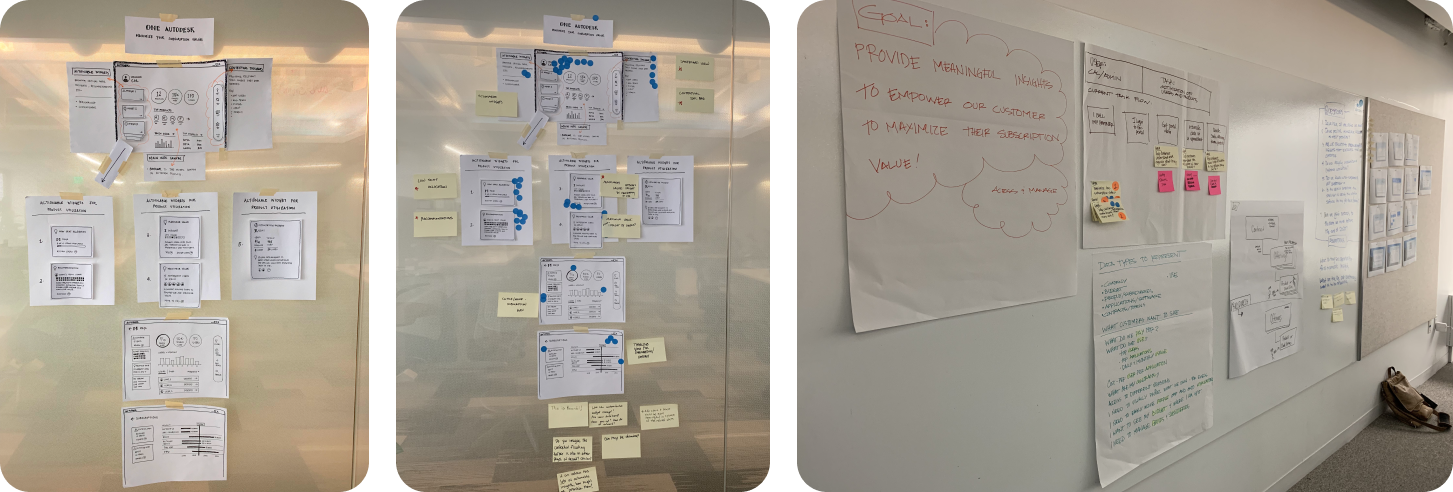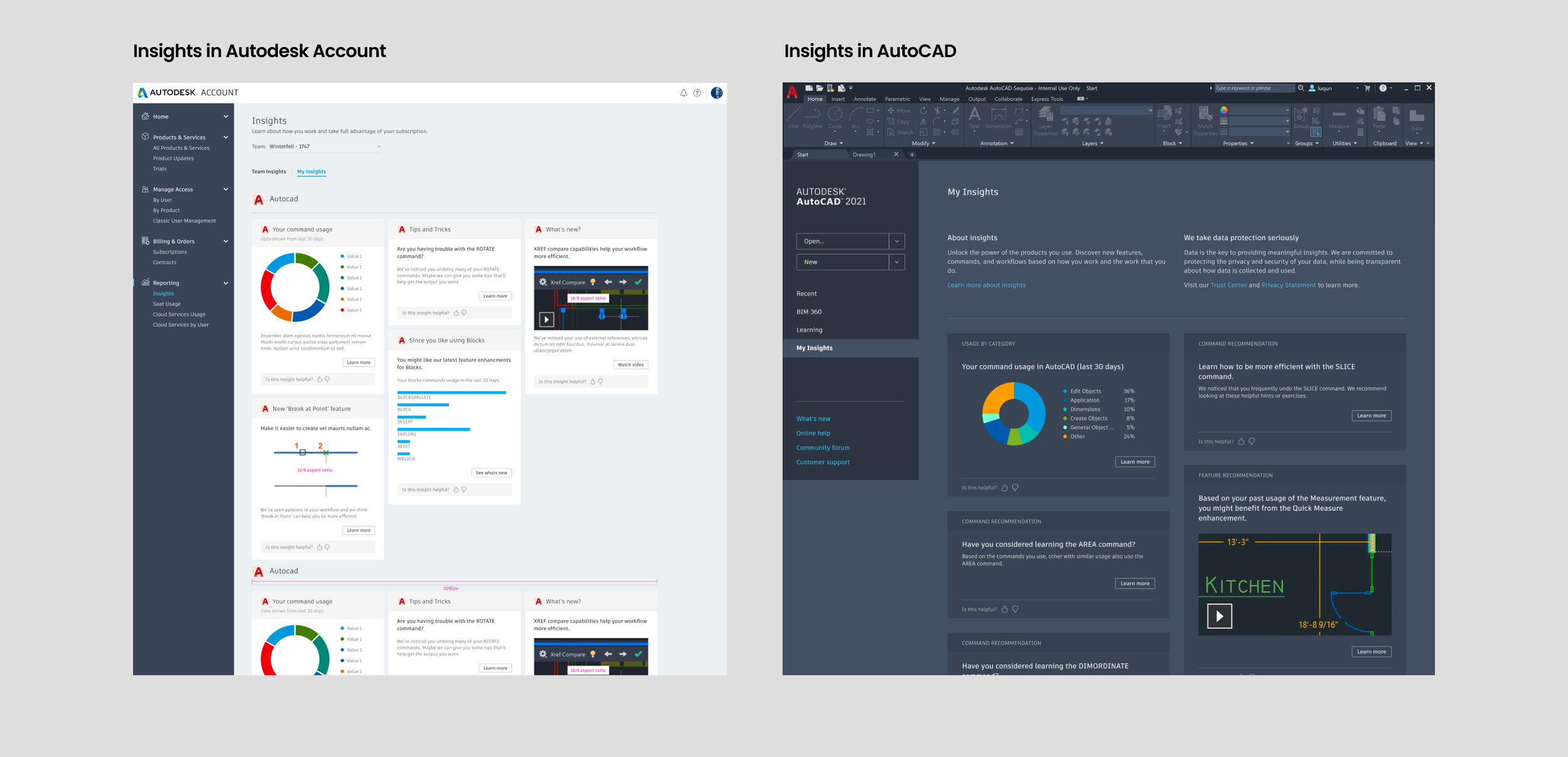Autodesk Insights Platform
As Autodesk transitioned from selling perpetual software licenses (serial numbers) to subscriptions and flexible pay-as-you-go plans, customers faced significant challenges in managing software usage, license allocation, and renewals. They lacked information and insights into how their teams were using Autodesk products, leading to manual tracking, inefficient spending, and suboptimal decision-making on software purchases and usage. This lack of transparency often resulted in unnecessary costs, underutilized licenses, and friction in renewal decisions.
As a UX Design Manager and Design Lead, I led the end-to-end design strategy and execution of a complex and scalable insights platform to empower Autodesk customers with data-driven decision-making capabilities.
Timeframe: 2020 -2022 (Multi-year strategic effort)
My Role
Vision and strategy: Defined and led the design vision, and strategy in collaboration with Product and Engineering leadership, prioritizing experiences and features to make complex information clear and accessible for Autodesk customers.
Cross-functional leadership and roadmap influence: Collaborated closely with Product, Engineering, Data Science, and Business Strategy teams to define and prioritize the product roadmap, ensuring strategic alignment. Contributed to quarterly OKRs, tracking success metrics post-launch.
Stakeholder and executive alignment: Regularly engaged with senior stakeholders, communicating the design vision, strategic impact, and progress, ensuring the platform aligned with business goals.
Decision-making and problem solving: Developed a structured decision-making framework to accelerate resolution of complex design, feasibility, and data challenges. Led trade-off discussions to balance technical constraints, business goals, and release timelines with Engineering and Product teams.
Leading and scaling UX design team: Managed and empowered a high-performing team of Senior UX Designers, providing clear direction, prioritization, and mentorship to drive execution excellence and faster value delivery in an Agile (Scrum) environment.
Problem
Autodesk customers, including technology managers, admins and end users, lacked clear, actionable insights into their product usage, product subscriptions and licenses. Many relied on raw, incomplete data or manually compiled reports using spreadsheets and third-party tools, leading to inefficiencies, errors, and time-consuming processes. This fragmented experience hindered their ability to make data-driven decisions on product adoption, renewals, and training, ultimately impacting business efficiency and software ROI.
How might we empower Autodesk customers with intuitive, timely and actionable insights that drive smarter decisions, enhance product adoption, and optimize software investments?
The Process
An Infinite Loop Approach for Continuous Delivery and Improvement
To successfully design, develop, and iterate our Insights Platform, we used an infinite loop process consisting of four iterative phases: Discover, Strategize, Develop, and Monitor. This approach ensured that customer insights continuously shaped the product experience, business goals remained aligned, and enhancements were made based on real-world data.
By using this continuous learning and iteration cycle, we minimized risk, maximized usability, and ensured the experience evolved to meet customer and business needs over time.
Infinite loop process consisting of four iterative phases: Discover, Strategize, Develop, and Monitor
Understanding Customer Needs
Multi-phase research: User research played a critical role in shaping the insights platform, ensuring that it solved real customer pain points and provided meaningful value. In collaboration with two user researchers, I led a multi-phase research initiative to deeply understand how Autodesk customers (technology managers, admins and end users) made decisions about their software subscriptions, licenses, and product usage.
Our research approach included:
Discovery and Strategy Research – Understanding current workflows, challenges, and decision-making needs.
Concept Validation – Testing early prototypes to validate usability and usefulness of insights.
Usability Testing – Conducting pre- and post-launch tests to refine the experience.
A/B Testing and Experimentation – Iterating on features to improve impact and adoption.
The initial research focused on understanding:
What are the key questions customers need answers to regarding their Autodesk product usage, product subscriptions and licenses?
What are the critical decisions and actions they need to make?
What information or data would enable them to make those decisions confidently?
Findings from initial user research and themes
I partnered with user researchers, analyzed the data, and looked at patterns. Through these research studies, I identified four major themes that shaped the design strategy of the insights platform.
Key themes from customer research
Make smarter data-backed decisions
Anticipate the future
Drive efficiency and productivity
Optimize the value of subscriptions
Pain Points:
Autodesk customers struggled to access clear, reliable insights on software usage and how well their teams were utilizing licenses, leading to guesswork in renewals, license allocation, and product adoption strategies. Many relied on manual reports and spreadsheets, making the process inefficient. They had no visibility into future needs, making it difficult to forecast usage trends, anticipate renewals, and justify software budgets.
Key Findings:
30% of companies discovered they were under assigned software licenses, leading to unnecessary expenses.
64% of customers wanted personalized insights on how to increase software adoption within their teams.
75% of admins said they lacked an intuitive way to view software usage trends, and relied on manual tracking, increasing the risk of errors and inefficient license allocation
70% of admins expressed a need for predictive insights to avoid unexpected license expirations or overages.
Key questions customers wanted to answer to make informed decisions:
"Do I need additional Autodesk subscriptions to provide more users with access? Do I have available Autodesk licenses that can be assigned to users to optimize our company's license utilization?"
"Are the right teams and users utilizing the appropriate product versions? Is my company standardizing on our preferred Autodesk product version? What is my company’s adoption rate for a specific product version?"
"When are my Autodesk subscriptions up for renewal?"
“When will my company exhaust its Autodesk Flex tokens, so that I can plan to purchase additional tokens?"
"How many Autodesk product seats (licenses) should I budget for next year, considering my company's current usage and future needs?"
Design Sprint
After the research in the discovery phase, we leveraged the Google Design Sprint methodology to rapidly validate ideas and align stakeholders and to ensure a user-centered approach. This structured, time-boxed framework helped us move from problem definition to tested prototype in just a few days, reducing uncertainty and accelerating decision-making. Cross-functional teams (UX, product, business, data science, and engineering) collaborated to map the admin’s decision-making needs and identify key pain points.
Instead of making assumptions, we needed to quickly validate what insights mattered most, how they should be visualized, and how customers would interact with them. The Google Design Sprint provided a structured way to achieve this goal.
The Google Design Sprint was not just a UX-driven effort—it was a collaborative, multi-disciplinary approach that ensured the insights platform was strategically aligned, technically feasible, and user-focused. This partnership was key to breaking silos and fostering collaboration.
My design sprint sketches and ideas for actionable insights with layouts and data visualization approaches, empowering customers to make smart, informed decisions. leading to diverse ideas that could be refined.
More explorations after refining the ideas from Design Sprint, refined based on customer feedback.leading to diverse ideas that could be refined.
Prioritization and Product Roadmap
Driving Strategic Impact
A key responsibility in leading the design strategy for the insights platform was ensuring that the right insights were prioritized, designed, and delivered in a way that maximized impact for both customers and the business. To achieve this, I worked closely with Business, Product Management and Engineering to define a phased launch approach, ensuring we delivered high-value insights early, while maintaining a clear roadmap for future iterations.
Platform Design Strategy: Systems Thinking and Modular Approach
A core part of my design strategy was systems thinking and modular thinking. I applied platform thinking, focusing on reusability, consistency, and long-term scalability to surface insights across different Autodesk products and digital touchpoints, and user roles. Instead of designing isolated insights, we built a flexible, component-based system that could support diverse admin needs while maintaining consistency across various insights. Through this approach, I enabled cross-product consistency, eliminated data silos, and created a scalable foundation for ongoing feature expansion. This strategy helped us in extending the insights to different customer workflows.
By embedding systems thinking early on, we eliminated data silos, ensured design consistency, and built a flexible foundation for ongoing feature expansion. By using a modular architecture, we enabled Autodesk to reuse these components across different products, reducing design and development effort while ensuring a consistent user experience.
To create a scalable and adaptable insights experience, we:
Established a Unified Insights Framework – Designed a modular system of reusable components (e.g., charts, trend indicators, data filters) that could be deployed across different Autodesk products.
Integrated with Multiple Channels – Enabled insights to be surfaced not only within Autodesk Account but also in in-product experiences, ensuring that critical insights were accessible in context.
Phased Launches: Delivering Value in Iterations
Rather than launching a fully built-out insights platform all at once, we adopted a phased release strategy, prioritizing high-impact insights first, followed by incremental enhancements based on user feedback and adoption trends. The following insights were prioritized for the first launch.
Under-assignment: Lists teams and products that have available seats for specific products.
Over-assignment: Lists teams with subscriptions that have users assigned to expired products.
Inactive user: Lists those who have not used their assigned products in the last 3 months. See Use Seat Usage to monitor product activation and frequency of use.
Product Version: Lists teams with usage on outlier product versions, defined as a version with less than 1% of the total days used by a team over the past three months.
Outcomes
The Autodesk Insights Platform not only enhanced the customer experience but also delivered measurable business impact, driving higher engagement, retention, and operational efficiency. By surfacing timely, relevant, and actionable insights, the platform empowered customers to make smarter decisions about their software usage, leading to significant improvements in key business metrics:
15% increase in renewal rate – Customers gained better visibility into usage trends and renewal needs, leading to higher confidence in subscription decisions and an increase in on-time renewals.
8% increase in product adoption rate – By providing clear insights into underutilized software, admins could drive better onboarding, training, and engagement, leading to greater product usage across teams.
30% increase in software assignment rate – Insight on unused or underutilized licenses enabled admins to reallocate resources efficiently, ensuring that more seats were assigned to active users.
20% reduction in licensing and renewal-related support cases – Customers gained self-service access to key insights, reducing the need to contact Autodesk support for questions related to renewals, license assignments, and usage tracking.
50% reduction in time-to-market through a systems thinking and modular design approach.









